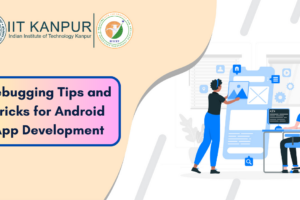How to Use Firebase to Build Real-Time Apps for Android
- Date July 31, 2023
To use Firebase to build real-time apps for Android, you can follow these steps:
Set up Firebase in your Android project:
- On the Firebase console, create a new Firebase project. (https://console.firebase.google.com/).
- Add your Android app to the Firebase project by providing the package name and other details.
- Download the google-services.json file and place it in the app module of your Android project.
Add Firebase Realtime Database to your Android project:
- Navigate to the “Realtime Database” area of the Firebase console.
- Click on “Create Database” and choose the “Start in test mode” option for simplicity.
- Once the database is created, you can retrieve the Firebase Realtime Database URL.
Add the Firebase SDK to your Android app:
- Open your app’s ‘build.gradle’ file and include the following dependencies:
implementation ‘com.google.firebase:firebase-database:20.0.0’
Initialize Firebase in your Android app:
- In your app’s main activity or application class, add the following code to initialize Firebase:
import com.google.firebase.FirebaseApp;
// Inside onCreate() method
FirebaseApp.initializeApp(this);
Read and write data in real time:
- To read data from the Firebase Realtime Database, you can add a ‘ValueEventListener’ to a database reference:
import com.google.firebase.database.DatabaseReference;
import com.google.firebase.database.FirebaseDatabase;
import com.google.firebase.database.DataSnapshot;
import com.google.firebase.database.DatabaseError;
import com.google.firebase.database.ValueEventListener;
// Get a reference to the root node of your database
DatabaseReference rootRef = FirebaseDatabase.getInstance().getReference();
// Read data once
rootRef.child(“path/to/data”).addListenerForSingleValueEvent(new ValueEventListener() {
@Override
public void onDataChange(DataSnapshot dataSnapshot) {
// Handle the retrieved data
Object value = dataSnapshot.getValue();
// …
}
@Override
public void onCancelled(DatabaseError databaseError) {
// Handle errors
// …
}
});
// Read data continuously
rootRef.child(“path/to/data”).addValueEventListener(new ValueEventListener() {
@Override
public void onDataChange(DataSnapshot dataSnapshot) {
// Handle the retrieved data
Object value = dataSnapshot.getValue();
// …
}
@Override
public void onCancelled(DatabaseError databaseError) {
// Handle errors
// …
}
});
- To write data to the Firebase Realtime Database, you can use the ‘setValue()’ method on a database reference:
// Write a single value
rootRef.child(“path/to/data”).setValue(“Hello, Firebase!”);
// Write multiple values
Map<String, Object> data = new HashMap<>();
data.put(“key1”, value1);
data.put(“key2”, value2);
rootRef.child(“path/to/data”).updateChildren(data);
Listen for changes in real time:
- As shown in step 5, you can use ‘addValueEventListener()’ to listen for changes to data in real time. This allows your app to receive updates whenever the data at the specified database reference changes.
Retrieve specific data using queries:
- Firebase Realtime Database supports querying data based on various conditions. You can use methods like ‘orderByChild()’, ‘orderByKey()’, ‘orderByValue()’, and ‘limitToFirst()’/’limitToLast()’ to retrieve specific data subsets.
Implement data synchronization:
- Firebase Realtime Database provides offline capabilities, allowing your app to work seamlessly even when the device is offline. The SDK automatically synchronizes the local database with the server when the device comes back online.
Handle data security:
- Firebase Realtime Database provides security rules that determine who can read and write data. You can define rules to authenticate users, validate data, and control access to different parts of the database. Make sure to review and set appropriate security rules for your app.
Leverage Firebase Authentication:
- Firebase offers a comprehensive authentication system that integrates smoothly with the Realtime Database. You can use Firebase Authentication to authenticate users and secure access to the database, ensuring that only authenticated users can read and write data.
Utilize Firebase Cloud Functions:
- Firebase Cloud Functions allows you to extend the functionality of your app by writing server-side logic. You can use Cloud Functions to process data, validate inputs, send notifications, and perform other tasks triggered by database events.
Optimize data retrieval:
- Consider structuring your database in a way that optimizes data retrieval. Firebase Realtime Database is a NoSQL database, so denormalization and data flattening techniques can be used to efficiently fetch data with minimal read operations.
Handle data updates efficiently:
- Firebase Realtime Database provides granular control over data updates. Instead of updating the entire object, you can use methods like ‘updateChildren()’ to update specific fields or use transactions to perform atomic updates. This helps minimize bandwidth usage and improves performance.
Use Firebase UI libraries:
- Firebase provides UI libraries that simplify the integration of Firebase services into your Android app. FirebaseUI-Android offers pre-built UI components for authentication, data binding, and more. It can save you development time and provide a consistent user experience.
Explore additional Firebase services:
- Firebase offers a wide range of services beyond the Realtime Database, including Cloud Firestore (a flexible, scalable NoSQL database), Firebase Cloud Messaging (for sending push notifications), Firebase Authentication (for user authentication), Firebase Analytics (for tracking app usage), and many more. Consider exploring these services to enhance your app’s functionality.
Test and monitor your app:
- Firebase provides tools for testing and monitoring your app’s performance. Firebase Test Lab allows you to test your app on real devices in the cloud, while Firebase Crashlytics helps you track and analyze crashes and errors. Monitoring tools like Firebase Performance Monitoring can help you identify performance bottlenecks and optimize your app.
Stay updated with Firebase updates:
- Firebase is regularly updated with new features and improvements. Stay connected with the Firebase community, read release notes, and follow the Firebase blog to stay informed about the latest updates. Keeping your app up to date ensures you can leverage new features and improvements.
Seek help from the Firebase community:
- If you encounter any issues or have questions while using Firebase, the Firebase community is a valuable resource. You can explore the Firebase Google Group, Firebase Stack Overflow tag, and Firebase Slack community for assistance and to connect with other developers.
Optimize data security with Firebase Security Rules:
- Firebase Security Rules allow you to define fine-grained access controls for your database. Take advantage of these rules to secure your data and ensure that only authorized users can read or modify it. Firebase provides a rule simulator to test and validate your security rules.
Handle data persistence with Disk Persistence:
- By default, Firebase Realtime Database stores data in memory. However, you can enable Disk Persistence to store data on the device’s disk as well. This allows your app to maintain its state and cache data, even if the user closes the app or the device reboots.
Utilize Firebase Cloud Messaging (FCM) for real-time notifications:
- Firebase Cloud Messaging is a powerful service that enables you to send real-time notifications to your app users. You can use FCM to send messages, trigger actions, and engage with your users even when they are not actively using your app.
Implement Firebase Remote Config for dynamic app behavior:
- Firebase Remote Config allows you to remotely configure your app’s behavior and appearance. You can use it to change app settings, update content, or A/B test different features without requiring users to update their app versions.
Leverage Firebase Crashlytics for crash reporting:
- Firebase Crashlytics helps you track and analyze app crashes. It provides detailed crash reports and insights, helping you identify and fix issues quickly. Integrate Crashlytics into your app to ensure a stable and reliable user experience.
Use Firebase Authentication for user management:
- Firebase Authentication offers a comprehensive set of features for user authentication and management. It supports various authentication methods, including email/password, social logins, and phone number verification. Integrate Firebase Authentication to handle user registration, login, and security.
Monitor app performance with Firebase Performance Monitoring:
- Firebase Performance Monitoring provides insights into your app’s performance and helps you identify areas for optimization. It tracks key performance metrics such as app startup time, network latency, and method traces, allowing you to improve the overall user experience.
Test your app with Firebase Test Lab:
- Firebase Test Lab allows you to test your app on a wide range of real devices in the cloud. It helps you identify issues related to device compatibility, UI responsiveness, and performance. Run automated tests and ensure your app works seamlessly across different devices and configurations.
Explore Firebase Extensions:
- Firebase Extensions are pre-built solutions that extend the functionality of Firebase. These ready-to-use extensions can help you save development time by integrating popular third-party services, implementing common features, and automating tasks in your app.
Use Firebase Cloud Firestore for more complex data structures:
- Firebase Realtime Database is suitable for simple data structures, but if you need more complex querying capabilities, hierarchical data modeling, or support for larger datasets, consider using Firebase Cloud Firestore. It is a NoSQL document-based database that offers powerful querying and scalability features.
Leverage Firebase Cloud Storage for file uploads:
- If your app requires file uploads, such as images or documents, Firebase Cloud Storage is a reliable solution. It provides secure and scalable cloud storage for your app’s files. You can easily upload, download, and manage files using Firebase Storage SDK.
Implement Firebase Analytics for insights into user behavior:
- Firebase Analytics allows you to track user interactions, measure app performance, and gain valuable insights into user behavior. By integrating Firebase Analytics into your app, you can monitor user engagement, conversion rates, and other key metrics to make data-driven decisions.
To use Firebase to build real-time apps for Android, you can follow these steps:
Integrate Firebase Performance Monitoring:
- Firebase Performance Monitoring helps you monitor and optimize your app’s performance. It provides detailed information about network requests, method traces, and app start-up times. Analyzing this data can help you identify and address performance bottlenecks.
Consider using Firebase In-App Messaging:
- Firebase In-App Messaging enables you to engage and communicate with your app users by delivering targeted and personalized messages directly within your app. You can display banners, modals, or images to convey important information, promotions, or updates.
Enable Firebase Remote Config for feature flagging:
- Firebase Remote Config allows you to enable or disable features remotely without requiring app updates. This feature flagging capability can be useful for gradual feature rollouts, A/B testing, or managing app behavior based on different user segments.
Implement Firebase A/B Testing:
- Firebase A/B Testing enables you to create experiments and test different variations of your app’s UI, features, or content. You can define goals, target specific user groups, and analyze the results to make data-backed decisions and improve user experience.
Follow best practices for optimizing performance and security:
- Be mindful of performance and security considerations. Minimize unnecessary data transfers, optimize database queries, and apply appropriate security rules to protect sensitive data. Regularly monitor and analyze your app’s performance metrics and user feedback to make iterative improvements.
Previous post
The Future of Work: How Artificial Intelligence is Shaping the Job Landscapes and Preparing the Workforce for the Future
Next post
Natural Language Processing (NLP) and its Role in Advancing Conversational Artificial Intelligence
You may also like

Creating custom animation in your Android app



